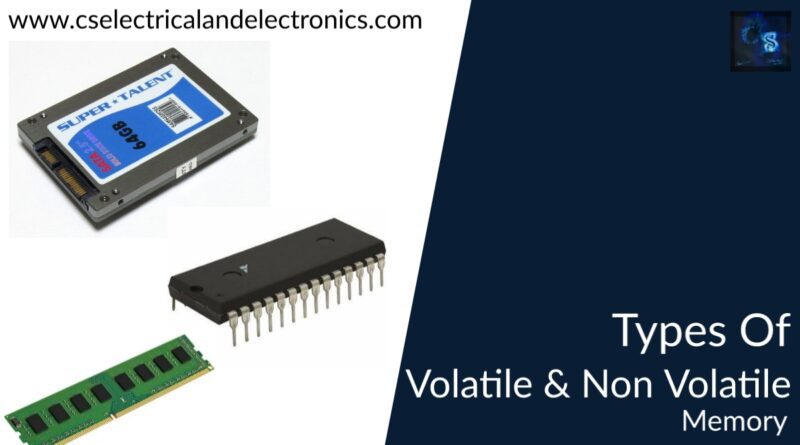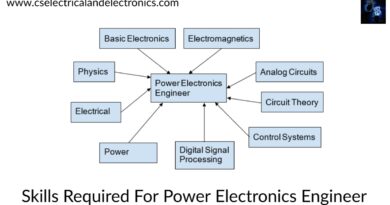Types Of Volatile And Non-Volatile Memory In The Market
Hello guys, welcome back to our blog. Here in this article, we will discuss the types of volatile and non-volatile memory in the market, short information on each type of volatile and non-volatile memory, and with advantages and disadvantages.
If you have any electrical, electronics, and computer science doubts, then ask questions. You can also catch me on Instagram – CS Electrical & Electronics.
Also, read the following:
- What Is ASIL A B C D, Purpose, Applications, Working, Examples
- Top 20 Interview Questions On Functional Safety In Automotive
- Top 20 AUTOSAR Interview Questions For AUTOSAR Engineers
Types Of Volatile And Non-Volatile Memory
What is a volatile memory?
Volatile memory is a type of computer memory that requires an electrical current to store data and is volatile to the power supply. It is temporary memory storage and once the power shuts down the stored information is erased. Usually, the information stored in volatile memory is the one that needs quick access by the CPU.
Hence, volatile memory storage does not keep a massive volume of information. All the quick commands that we provide are frequently stored in volatile memory and retrieved when they need quick access. The volatile memory storage is placed outside the motherboard or in a memory slot. We can examine the capacity of the memory through the operating system. In the windows operating system, we can check the RAM memory capacity using the following instructions:
- Click the Start button.
- Run the Command Prompt and Select Run as the administrator option.
- To find the RAM memory capacity, run the following command: wmic memory chip gets device locator, capacity.
What are the types of volatile memory?
Volatile memory only stores information that the CPU needs to quickly access. Hence, volatile memory can also be known as primary memory. They are mainly of the types given below:
- RAM (SRAM, DRAM, and VRAM).
- Cache memory.
- HDD Disk cache.
- SSD Disk cache.
RAM (Random Access Memory)
A RAM has volatile memory because the information stored in memory is deleted when power interrupts. The CPU utilizes RAM for quick access to information. Hence, requires only minimum memory capacity. There are three types of RAM that majorly exists:
- SRAM (Static Random Access Memory).
- DRAM (Dynamic Random Access Memory).
- VRAM (Video Random Access Memory).
DRAM (Dynamic Random Access Memory)
The DRAM is the most commonly used primary memory by various digital electronics. To store every bit of information, DRAM needs one capacitor and one transistor, which makes it compact and economical.
Advantages of DRAM
- It is easier to integrate all types of digital electronic devices.
- Cost-effective.
- Highly reliable.
- Consumes lesser power.
- The cost per bit is low.
- Simple architecture.
- Store huge data, that is quickly accessible.
- It can refresh and erase data automatically
Disadvantages of DRAM
- Performance speed is low.
- Needs to be refreshed continuously.
- Discontinuity of data.
Applications of DRAM
- Laptops, computers, and servers.
- Digital devices.
- Enhance graphics function.
- Reduced memory capacity.
SRAM (Static Random Access Memory)
The SRAM generally stores data that is quickly accessible to the CPU. Compared to DRAM, SRAM requires four transistors and two coupled inverters to store each bit of information. They are generally used as CPU cache memory, and no periodical refreshing is required. Thus the complexity of SRAM is high, power consumption is high and so is the expense.
Advantages of SRAM
- Lesser idle time.
- Periodical refreshing is not needed.
- Highly reliable and best performance.
- Quick access by the CPU compared to DRAM.
Disadvantages of SRAM
- High power consumption compared to DRAM.
- Complex architecture.
- Economically unreliable.
- Storage capacity is low.
- More volatile on memory storage.
Applications of SRAM
- They are mainly used as CPU cache memory, processor registers, hard disk buffers, LCD screens, networking devices, etc.
- Microprocessors, analog to digital converters, and CPU registers.
- It is also employed in medical equipment, printers, and various computer applications.
VRAM (Video Random Access Memory)
The VRAM plays an important role in video and graphics quality enhancement. If your application requires a better gaming experience, it is the role of VRAM to improve complex graphics and images. Built-in VRAM helps the users to ensure an enhanced execution of graphics display. It also helps in the display of complex 3-D images.
Advantages of VRAM
- Graphics chips provide faster performance in loading high-quality images and videos.
- For a better gaming experience, VRAM furnishes complex textures and high-quality images.
- It acts as a medium between a video card and the CPU.
Disadvantages of VRAM
- Built-in video cards make the applications run slower.
- Switching between applications consumes more time.
- System stability may reduce.
- Larger programs may run in a system with a lower RAM size.
- Considerable increase in heat output of the CPU.
Applications of VRAM
- Reducing loading times for graphics, images, and HQ videos.
- Enhances gaming experience.
- Used for video games and 3-D graphic design programs.
What is non-volatile memory?
In contrast to volatile memory, non-volatile memory does not require constant power to retain stored information. The non-volatile memory can retrieve stored data even after power interrupts. Non-volatile memory stores data in floating-gate memory cells. They do not need a periodical refresh to retrieve data. Hence, they are employed for consistent data storage. USB memory sticks and digital cameras employ non-volatile memory storage. Non-volatile data storage is mainly classified into two:
- Mechanically addressed system.
- Electrically addressed system.
Mechanically addressed system
Hard disks, Optical disks, holographic memory, and magnetic tapes are some of the mechanically addressed memory systems. It can write and read on a selected storage medium and can hold huge data. The speed of accessing information depends on the physical location of the data on the storage medium.
For example, magnetic tapes stores information as bits in sequence and retrieve stored information when a recording head moves along the tape. Likewise, hard disks are magnetic storage devices, and accessing information takes a longer time compared to a randomly accessed memory system. A plastic disk with altering pigment layers makes an optical disk.
Electrically addressed system
This non-volatile data storage is based on the write mechanism. Although it is costlier than a mechanically addressed system, it has a faster response. Some examples of an electrically addressed memory system include:
- Read-only memory of all types.
- Flash memory.
- Ferroelectric Random Access Memory (FRAM).
- Magnetic Random Access Memory (MRAM).
- Phase -change memory (PCM).
- Resistive Random Access Memory (RRAM).
Read -mostly storage
EPROM is one of the non-volatile memory storages which are erasable and written once again with a special programmer circuit. An EEPROM utilizes voltages to erase memory. Usually, they are time-consuming to erase and write new information.
Flash memory
Flash memory is a storage system that can store enormous data without using an external power source. It’s an advancement of EEPROM except that to erase memory, each block is erased on a sequential basis.
FRAM
FRAM is relatable to DRAM, where in FRAM instead of a simple dielectric capacitor, a thin ferroelectric film of lead zirconate titanate which can change its polarity on applying an electric field is used. Because of this property, FRAM can restore data even when power interrupts.
MRAM
MRAM stores data in magnetic storage elements, which use field-induced writing on the elements. Those elements are called Magnetic Tunnel Junctions (MJTs).
PCM
PCM works on binary switching states “1” and “0”, with a help of a crystalline element called chalcogenide glass. By heating and cooling off the glass, it can switch states between crystalline and amorphous. The crystalline phase has low resistance and hence allows current and the amorphous has high resistance and thus blocks the current. These states represent the binary switching states.
This was about “Types Of Volatile And Non-Volatile Memory“. I hope this article may help you all a lot. Thank you for reading.
Also, read:
- 100 + Electrical Engineering Projects For Students, Engineers
- 1000+ Electronics Projects For Engineers, Diploma, MTech Students
- 1000+ MATLAB Simulink Projects For MTech, Engineering Students
- 500+ Embedded System Projects For Engineer, Diploma, MTech, PhD
- 500+ Projects For Diploma Electrical, Electronics Student, Diploma Project
- 8051 Microcontroller Timers, TCON Register, TMOD Register
- Advancements In 3D Printing Technology And It’s Future
- Advancements In Power Electronics For Energy Efficiency
Author Profile
- Chetu
- Interest's ~ Engineering | Entrepreneurship | Politics | History | Travelling | Content Writing | Technology | Cooking
Latest entries
 All PostsApril 29, 2024Top 11 Free Courses On Battery For Engineers With Documents
All PostsApril 29, 2024Top 11 Free Courses On Battery For Engineers With Documents All PostsApril 19, 2024What Is Vector CANoe Tool, Why It Is Used In The Automotive Industry
All PostsApril 19, 2024What Is Vector CANoe Tool, Why It Is Used In The Automotive Industry All PostsApril 13, 2024What Is TCM, Transmission Control Module, Working, Purpose,
All PostsApril 13, 2024What Is TCM, Transmission Control Module, Working, Purpose, All PostsApril 12, 2024Top 100 HiL hardware in loop Interview Questions With Answers For Engineers
All PostsApril 12, 2024Top 100 HiL hardware in loop Interview Questions With Answers For Engineers








